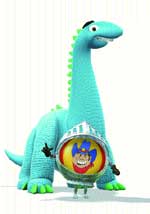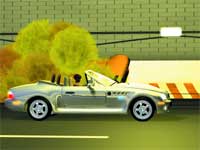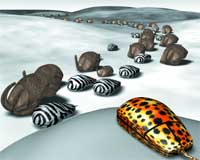To be at the right place at the right time seldom is the result of pure luck. Considering that many 3D animators today are wondering where exactly those places are, Lumentik's story is all the more interesting. A Manhattan newcomer, Lumentik (www.lumentik. com), like others interviewed for this article, faces marketplace challenges and their solution - applying their talent to an overlooked market - is ingenious for its timing.
Luminetik is working on a 3D animated television pilot for a network titled Dis-Konnected. Dis-Konnected is a story about a strong female character named "Alex," who has Matrix-type moves. She is a professional thief who works for government agencies and steals data. Her rival is a ninja thief who hides his identity behind his ninja mask. He steals for entirely different reasons. His identity and motivation are revealed throughout the
storyline, making you wonder if he is a good guy or bad guy. The story is surrounded by lots of action, as the two thieves are pursued by military intelligence and police. "We chose to pursue 'longform' content creation for various markets. The potential for merchandising and licensing is a good revenue model and the opportunities are endless," says CEO Kevin Cahill. "Shrek, Monsters, Inc. and Jimmy Neutron broke an animation box office record at $788 million dollars. Shrek has also did another $420 million in video sales. In a slow economy, these movies are making great money. Stories are very important combined with some of the top animation talent - there is a market there."

Thanks to 3D Studio Max 4.2's Inverse Kinematics, Rainbow Studios was able to squash and stretch characters for Donner, a half-hour Christmas special.
|
The studio's animators work mostly with NewTek LightWave 7 and Alias|Wavefront Maya 3 on IBM NT boxes. Their talent is formidable. This new group hails from other major studios: a visual effects supervisor is from Digital Domain, a character animator from Blue Sky, a visual effects artist from LAs' Available Light. A satellite office in Santa Monica houses two Pacific Data Images founders, Nick Isyll and Mike Necci. Cahill's background is architectural animation. They've been working together for two years now but only got into commercial work this past fall. Two TV pilots for animated series are being created in LightWave. The studio has created dozens of 3D animations, using Cycore's Cult 3D, for Hewlett Packard's briefing room, a training center for HP products. Lumentik's goal is to create its own material for different markets, such as gaming or television, though it realizes that commercial work will be the only way to fund that.
Referring to the industry climate, Cahill says, "For the last three months it's been really dry. It's been a challenge. But we're not jumping in for the major overhead, we're doing it low overhead and building our profile and reputation that way. If one market goes down we can jump to the other and try and have one cover the other. Government jobs - the good thing about that is once you get into their little realm you stay in their graces."
Luminetik is very excited about David Isyomin, the new director of visual effects, who joins the studio from Digital Domain where he worked on the features True Lies, Apollo 13, Chain Reaction, Dante's Peak and Titanic. Isyomin is also credited with working on the Volkswagen Turbonium spot.
Generalists
Phactory Productions Inc. (www.phactory.com), another New York newcomer, decided to meet industry challenges through promotion of its distinctive attributes. Co-founders Damijan Saccio and Scott Sindorf spied that 3D animation niche in 2000 and jumped in with their "smaller is better" philosophy.
"We figured with our technical expertise and, more importantly, ability to design, we'd open a 3D shop given the fact there aren't a lot of shops that specialize solely in 3D in New York City," they said. They've done spots and promos for Coca-Cola, MTV, cable and other networks. About 80 percent of their work is effects, 20 percent character. In addition to their broadcast design backgrounds, both teach at The School of Visual Arts (NYC) and Renssalaer Polytech Institute in Troy, N.Y.

Clever Image/Vetor Zero created 35 characters for The Storyteller Cafe. They rendered on Linux and NT farms.
|
On a local note, Phactory faced other challenges. The southern border of Manhattan's Ground Zero is where they are located and the business was shut for nearly a month following the 9/11 attacks. Luckily, neither employees nor the physical facility was hurt, plus the company had decent insurance.
Phactory has no fat in its facility. There are no Digi Beta decks, no Flame suite. They do all the compositing themselves, using Adobe After Effects and Apple Final Cut Pro. Though Web-based servers are SGI 02 machines, servers are Linux-based and AE runs on Macintoshes, it's primarily an NT-based shop with Boxx Technology workstations running Softimage|3D and XSI for 3D applications.
A :30 PlayStation2 game spot promoting Jack and Dexter ran on Cartoon Network prior to Christmas. Phactory designed and animated it for producers Freestyle Collective. It is character animation in a whole new outerspace world. Sindorf notes, "They needed to do it efficiently. Because we're a smaller shop we were able to do a much better job than anything they've been able to get so far and at a reasonable price.
"Another way we distinquish ourselves from a lot of larger houses is that we are generalists. We don't specialize in character animation, we don't specialize in technical direction - we do everything. In this market, especially for a small office, it's almost impossible to specialize and be successful," they said. Sindorf adds that Phactory's small size, a half-dozen people including the founders, streamlines the communication between client and creator. And since they're technology wonks and nimble enough to stay current, they often call friends on the West Coast for technique secrets. They've developed a close relationship with Areteis.com, a company that makes realistic water simulations.

Luminetik used LightWave 3D running on a Mac to create Dis-Konnected, a network pilot that will debut this spring.
|
EXPERIMENT
Rainbow Studios (www.rainbowstudios. com) in Phoenix decided to experiment with new tools and functions on a project that resulted in Donner, the half-hour Christmas special on ABC about one of Santa's reindeer. The client was TV Loonland working with Sunbow, a New York production company. (Editor's note: Rainbow was acquired by THQ Inc. in early January. Tony Sutterheim, president/animation and Mark DeSimone, president/games, will continue to manage their divisions.)
"[Discreet] 3D Studio Max's Inverse Kinematics system has been completely rewritten in version 4," says Rainbow animator Chris Baranowski. "That did allow us to do different things that we couldn't have done previously with getting the characters to squash and stretch the way we wanted them to in the cartoony way."
Adds director Sutterheim, "When I first saw the drawings for Donner I thought this is just a 2D show. Why do they want to do it 3D? This was before Shrek was so popular. The company was convinced that they wanted to try it CG, the creator was convinced it could be pulled off in CG. It was something that I hadn't seen before, that sort of Ren & Stimpy squash and stretchy looking CG animation. Usually it's very mechanical looking, not very organic. I was really amazed when I first saw some of the things that Chris was doing with the IK setups. He and the other guys here were able to set it up in a way that made it very intuitive for the animators - who were very talented character animators - to jump right in and use the tools very quickly."
Max v. 4.2, on Boxx Technology NT workstations, was used for the entire production, for modeling, setting up the characters and scenes and animation. It took Rainbow animators eight weeks, including nights and weekends, to complete the show.

Viewpoint used Maya and Flame on this Desktop Animal project for Cox Cable.
|
Rainbow Studios opened four years ago. Animation projects account for half its mix, the other half is games. Other episodic TV shows include Starship Troopers.
Sutterheim says the challenges Rainbow faces are the same this year as last: "Budgets are definitely shrinking and the quality bar is rising, so it makes it difficult to find a happy medium where you can produce a good quality show you're happy with and still break even. The barrier to entry in this industry is fairly low. Three guys can go out and buy a copy of Max and set up three computers in their house and call themselves an animation studio. That provides a challenge to the bigger houses to compete with that because the people we have here are very skilled and very good at what they do, and we like to compensate them that way. If it's quality they're looking for and assurance of delivery on time then we can provide that. It's the old, 'You want it fast, cheap or good? Pick two.' That remains our biggest challenge. We won't allow ourselves to do a lower quality of work, and that requires a certain amount of budget and that's very tough to find these days."
TRUST
At Viewpoint Studios (www.viewpoint studios.com) in Boston, a 15-year-old broadcast design and visual effects house for cable and network projects, they have addressed client budget concerns with quicker tools. The final piece of a successful working relationship, though, is to get the clients to trust the streamlined approval process.
"In broadcast, you've got to sell the idea almost before it's completed. So our role here is to do the 3D but we do quite a bit of precompositing in After Effects and other programs to get the client an idea of how the final composition is going to look when all the elements are married together," says CG artist Michael Leone, who worked with CG artist David So. From one desk we can go a lot further than we did a year ago. Also, we do 95 percent of our reviews on the Web. We do QuickTime movies where we post stuff and get feedback from clients within hours rather than FedEx stuff. So if client is pretty comfortable and they know we can complete the work, and it looks good, then they're usually pretty savvy with being able to review stuff on the Web. It's a lot cheaper. Also in the past year we've improved our 3D capabilities as far as workstations - more power, our Open GL engines, our 3D previz stuff that we do on the machines now takes a lot of the guess work out of rendering stuff for final and lets us be a lot more confident about how stuff looks before we leave at night to render."
Maya 4 on SGI 02 workstations and three Windows 2000 NT stations are the primary animation tools. Two SGI Octanes are used for rendering. Conversion is underway from the SGI to NT platform. The production house also has two Flames and an NT station for After Effects and Combustion.
For a :30 spot for Cox Cable, provider of high speed Internet services and cable, Viewpoint created Desktop Animal, a world of computer mice turned into various animals. Cox was represented with a cheetah, DSL was a zebra and dial-up was an elephant. The 3D characters were based on a print piece. The CG artists made the animals stretchy like silly putty in order to show their movement. The spot aired in Las Vegas and the West Coast. Maya was used for 3D animation, particle systems, rendering, surfacing and lighting. All elements - land, particle systems, characters and background - were created separately and combined in Flame.
EXPERIENCE
Cleber Redondo, president of Clever Image (www.cleberimage.com) in Fairview, N.J., has used various approaches to navigate today's choppy waters. The high-end 3D/compositing shop, which specializes in character animation and tends to do longform projects, hooked up a few years ago with sister company Vetor Zero, the commercial division. Longform series like the three-part The Storyteller Cafe, produced for the Christian Broadcast Network, raise Cleber Redondo's profile. The commercial projects through Vetor Zero raise the revenue. Clever also constantly upgrades its tools and, most importantly, it has learned to streamline the animation production.
The final 1/2-hour episode of The Storyteller Cafe will air this month. Previous episodes were broadcast at Thanksgiving and the Christmas prior to that. Initially, the client brought 2D characters to Redondo and contracted him to turn it all into a 3D series. The animators have learned from their mistakes. The first episode had a five-month turnaround and characters had to be created from scratch. It used Viewpoint Data Labs to help build the characters but by the third show had rebuilt and redesigned much of it. There are 400 different set-ups for the lights alone, but by that final show the process was much easier.
"We deal with 35 characters," says Redondo. "The problem is the crowd scenes. The way we come up with the solution is we do tons of passes. In a scene we have five to six characters, they're all animated separately and then we composite them together again. This is the thing we didn't do in the past, we tried to render it together. This speeds it up. Now we've built an NT farm which is pumping day and night. This way the renders never get delayed. The studio has NT and Linux renderfarms, with 20 dual processors bought and built from scratch. Proprietary software helps manage workflow for keyframing, animation and pipelines for composites and rendering. Discreet Combustion and Flame on SGI Octanes are used for compositing.
"The problem is a lot of work and the prices just going down, down," says Redondo. "It's a Catch 22 how we handle demand and dropping prices. The demand is a problem but so is the speed. If they want the shows done quickly it costs a lot of money. The most costly part on the show is the manpower. We try to overlap. It takes longer but after six to seven months we have three shows done. As incredible as it sounds, the renders always catch up."